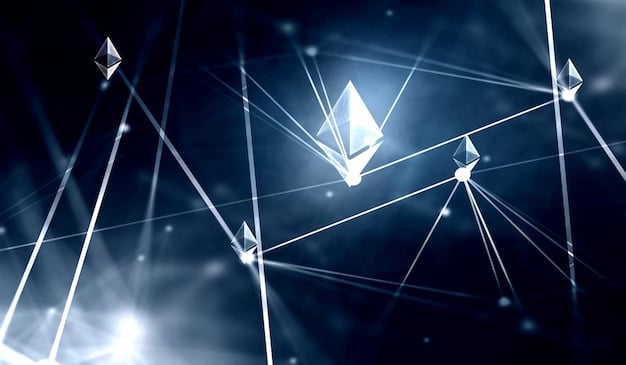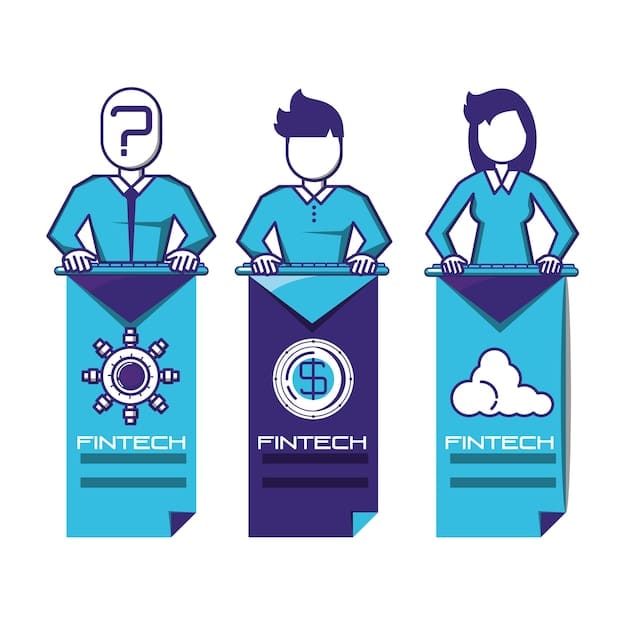DeFi Scalability: Layer-2 Options for US Investors

DeFi scalability solutions, particularly Layer-2 options, address blockchain’s transaction speed and cost limitations, offering US investors enhanced efficiency and accessibility in decentralized finance.
The decentralized finance (DeFi) landscape offers considerable opportunities for US investors, but it’s frequently hampered by scalability issues. DeFi scalability solutions: exploring layer-2 options for US investors, are crucial for overcoming limitations related to transaction speed and costs, paving the way for more efficient and accessible decentralized finance applications.
Understanding DeFi Scalability Challenges for US Investors
For US investors delving into the world of DeFi, grasping the existing scalability challenges is critical. These challenges impact transaction speeds, costs, and overall user experience, hindering widespread adoption.
Transaction Speed and Throughput
One of the primary bottlenecks in DeFi is the limited transaction speed and throughput of many blockchain networks. This can lead to delays and frustrations for users.
High Transaction Costs (Gas Fees)
High gas fees, especially during periods of network congestion, make smaller transactions economically unviable. This barrier prevents many potential users from participating in DeFi.
Network Congestion Issues
The Ethereum network, which hosts many DeFi applications, often faces congestion issues. This congestion exacerbates the problems of slow transaction speeds and high gas fees.

To mitigate these challenges, various layer-2 scaling solutions have emerged. These solutions aim to increase transaction throughput and reduce costs without compromising the security or decentralization of the underlying blockchain.
- Optimistic Rollups: Batch transactions off-chain and post them to the main chain, assuming validity unless challenged.
- zk-Rollups: Use zero-knowledge proofs to validate batched transactions, offering faster finality and reduced gas costs.
- Sidechains: Independent blockchains that run parallel to the main chain, enabling faster confirmations and lower fees.
Understanding these challenges and the potential solutions is essential for US investors looking to navigate the DeFi space effectively. The right scalability solutions can unlock new opportunities and improve the overall DeFi experience.
Exploring Optimistic Rollups: A DeFi Scaling Solution
Optimistic rollups are a layer-2 scaling solution designed to improve the efficiency of blockchain transactions. They function by bundling multiple transactions into a single batch and executing them off-chain, which helps to reduce the load on the main Ethereum network.
How Optimistic Rollups Work
Optimistic rollups operate on the assumption that transactions are valid unless proven otherwise. This “optimistic” approach allows for faster processing times.
Key Advantages for US Investors
US investors can benefit significantly from optimistic rollups, especially those engaging in high-frequency trading or smaller transactions.
Potential Drawbacks and Challenges
Despite their advantages, optimistic rollups do have certain limitations that US investors should consider.
One of the primary drawbacks is the challenge period, during which anyone can dispute the validity of a transaction. This period can delay the finality of transactions, which might not be ideal for time-sensitive operations.
Popular optimistic rollup platforms include Arbitrum and Optimism, both of which are actively working to improve DeFi accessibility. These platforms offer tools and resources for developers to build and deploy scalable DeFi applications.

The integration of optimistic rollups is enabling more users to participate in DeFi without the burden of high transaction costs and slow processing times. For US investors, this represents a significant step forward in making DeFi more practical and accessible.
zk-Rollups: Enhancing DeFi Scalability with Zero-Knowledge Proofs
zk-Rollups, or Zero-Knowledge Rollups, represent another promising layer-2 scaling solution in the DeFi space. They use zero-knowledge proofs to validate transactions, providing enhanced scalability and efficiency.
Understanding Zero-Knowledge Proofs
Zero-knowledge proofs allow one party to prove to another that a statement is true without revealing any information beyond the validity of the statement itself.
- Increased Privacy: Users can prove they meet certain conditions for a transaction without revealing sensitive information.
- Lower Gas Costs: By validating transactions in batches, zk-Rollups significantly reduce gas costs compared to mainnet transactions.
- Faster Finality: Transactions are validated almost instantly, providing quicker finality compared to optimistic rollups.
Benefits for US Investors
US investors can leverage zk-Rollups for more efficient and private transactions within the DeFi ecosystem.
Limitations and Considerations
While zk-Rollups offer numerous advantages, they also pose certain challenges that US investors should be aware of.
One of the main limitations is the complexity of implementing zero-knowledge proofs. This complexity can make it more difficult for developers to build and deploy applications on zk-Rollups.
Examples of zk-Rollup platforms include StarkWare and zkSync, which are actively developing innovative solutions to enhance DeFi scalability and privacy. These platforms offer resources and tools for developers to build and deploy scalable DeFi applications.
By utilizing zero-knowledge proofs, zk-Rollups offer a powerful way to enhance DeFi scalability and privacy. For US investors, this technology enables more efficient and secure transactions within the DeFi ecosystem.
Sidechains: An Alternative Approach for DeFi Scaling
Sidechains offer a different approach to DeFi scaling by creating independent blockchains that run parallel to the main chain. This parallel structure allows for faster transaction processing and lower costs.
How Sidechains Function
Sidechains operate as separate blockchains with their own consensus mechanisms, which can be optimized for speed and efficiency. They are connected to the main chain through a two-way peg.
Advantages for US Investors
US investors can benefit from sidechains through faster transaction times and reduced costs, making them suitable for high-volume trading and smaller transactions.
Potential Risks and Trade-offs
While sidechains offer several advantages, they also come with potential risks and trade-offs that US investors should consider.
One of the primary concerns is the security of the sidechain. Because they often have their own consensus mechanisms, sidechains may be more vulnerable to attacks if they do not have sufficient decentralization or robust security measures.
Examples of Sidechain Projects
Popular sidechain projects include Polygon (Matic) and Skale, which are designed to improve the scalability of Ethereum-based DeFi applications. These platforms offer tools and resources for developers to build and deploy scalable DeFi applications.
Sidechains provide an alternative scaling solution that can be particularly effective for specific use cases within DeFi. For US investors, understanding these benefits and risks is essential for making informed decisions about which platforms and solutions to use.
Evaluating DeFi Scalability Options for US Investors
When evaluating DeFi scalability options, US investors need to consider several factors to determine the best approach for their specific needs. These factors include transaction speed, cost, security, and the overall complexity of the solution.
Key Considerations for US Investors
US investors should weigh the trade-offs between different scalability solutions to find the best fit for their investment strategies.
- Transaction Speed: Optimistic rollups, zk-Rollups, and sidechains offer varying levels of transaction speed.
- Security: Each scaling solution has its own security model, with different levels of risk.
- Cost Effectiveness: Compare the transaction costs of different layer-2 solutions to determine which is most economical for your trading volume.
Comparing Layer-2 Solutions
A detailed comparison of layer-2 solutions can help US investors make informed decisions.
Future Trends in DeFi Scaling
The future of DeFi scaling is likely to involve a combination of different layer-2 solutions working together to create a more scalable and efficient ecosystem.
Emerging trends include the development of hybrid solutions that combine the strengths of optimistic rollups and zk-Rollups, as well as the integration of new technologies such as sharding to further improve scalability.
Regulatory and Compliance Considerations for US Investors
Navigating the regulatory landscape is crucial for US investors participating in DeFi. Compliance with existing laws and regulations is essential to avoid legal issues and ensure long-term sustainability.
Understanding US Regulatory Requirements
US investors need to be aware of the regulatory requirements that apply to DeFi activities, including securities laws, tax regulations, and anti-money laundering (AML) requirements.
Compliance Strategies for DeFi Investors
Implementing effective compliance strategies can help US investors navigate the regulatory landscape with confidence.
One key strategy is to conduct thorough due diligence on DeFi projects and platforms to ensure they comply with all applicable laws and regulations. This includes verifying the project’s legal structure, reviewing its terms of service, and understanding its compliance policies.
Consulting with legal and tax professionals who specialize in DeFi can provide valuable guidance and help investors stay informed about the latest regulatory developments. These professionals can help investors understand their obligations and develop strategies to minimize their risk of non-compliance.
The Future of DeFi Regulation in the US
The regulatory landscape for DeFi in the US is constantly evolving, with new laws and regulations being introduced regularly. US investors need to stay informed about these developments to ensure they remain compliant.
Regulators like the Securities and Exchange Commission (SEC) and the Commodity Futures Trading Commission (CFTC) are actively examining the DeFi space and considering new rules to address the unique challenges and risks it poses.
How can Layer-2 scaling solutions enhance DeFi accessibility for US investors?
What are the main advantages of Optimistic Rollups for DeFi scalability?Layer-2 Scaling.
How do zk-Rollups use zero-knowledge proofs to improve transaction efficiency?Layer-2 Scaling.
What role do sidechains play in enhancing DeFi transaction speeds and reducing costs?Layer-2 Scaling.
What regulatory considerations should US investors keep in mind when using DeFi?Layer-2 Scaling.
Conclusion
In conclusion, DeFi scalability solutions: exploring layer-2 options for US investors, is essential for the long-term growth and accessibility of DeFi. By addressing the challenges of transaction speed, cost, and network congestion, Layer-2 options are opening new doors for US investors to participate in this innovative financial ecosystem.





